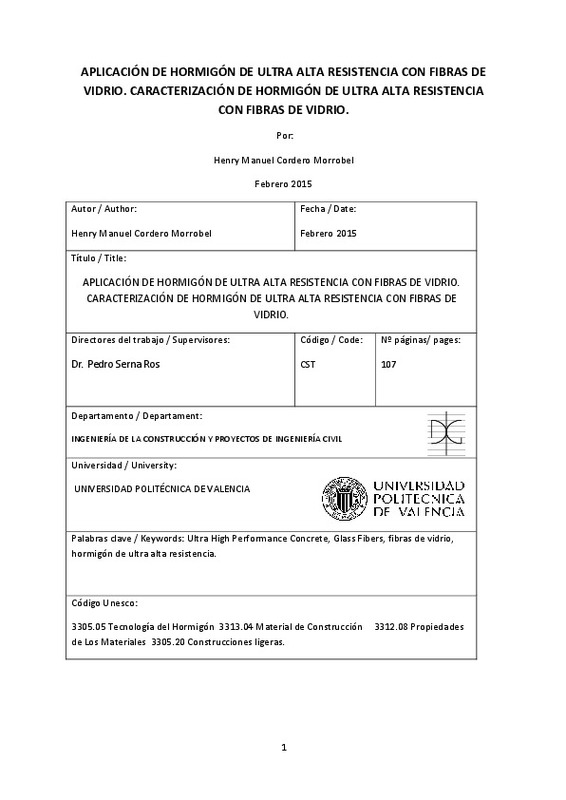JavaScript is disabled for your browser. Some features of this site may not work without it.
Buscar en RiuNet
Listar
Mi cuenta
Estadísticas
Ayuda RiuNet
Admin. UPV
Aplicación de Hormigón de Ultra Alta Resistencia con fibra de vidrio. Caracterizacion de hormigón de Ultra Alta resistencia con fibras de vidrio
Mostrar el registro sencillo del ítem
Ficheros en el ítem
| dc.contributor.advisor | Serna Ros, Pedro
|
es_ES |
| dc.contributor.author | Cordero Morrobel, Henry Manuel
|
es_ES |
| dc.date.accessioned | 2016-05-17T10:48:12Z | |
| dc.date.available | 2016-05-17T10:48:12Z | |
| dc.date.created | 2015-02-24 | |
| dc.date.issued | 2016-05-17 | |
| dc.identifier.uri | http://hdl.handle.net/10251/64232 | |
| dc.description.abstract | [EN] An Ultra High Performance Fibre Glass Reinforced Concrete has been developed in order to see the addition of Glass fibers in the matrix of UHPC and analyze their effects. The UHPC offers great advantages in strength, durability and surface finish. The addition of glass fibers is to improve the properties of UHPC. For decades the concrete has evolved from traditional concrete, fiber concrete, Self-Compacting concrete and high performance concrete to become what is now known as Ultra High Resistance Concrete (HMAR) or Ultra High Performance Concrete (UHPC). Has developed an experimental investigation incorporating different types of fibers and with the objective of the glass fibers and taking as reference steel fibers. There have been more than fifty 300X150X20mm specimens which have been subjected to tensile bending tests with bending 4-point method. The experimental program was composed of two blocks in which different properties of samples with UHPRFC both fresh and hardened state were analyzed. The results showed that the Ultra High Performance Fibers Reinforced Concrete (UHPRFC) increases its performance by incorporating fibers. Glass fibers increase the strength and ductility of UHPC without changing the workability of the dough whereby a Self-Compacting concrete behavior remains. Moreover the durability of the glass fibers has been affected over time but still offered better performance than the UHPC without fibers. Steel fibers and synthetic fibers showed improved, first steel fibers consumption rose from very high so the strength and ductility of the samples even surpassing the samples with glass fibers, however synthetic looked more relegated all properties analyzed. | es_ES |
| dc.description.abstract | [ES] Un Ultra High Performance Reinforced Glass-Fibre Concrete se ha desarrollado con el objetivo de ver la incorporación de fibras de vidrio en la matriz del UHPC y analizar sus efectos. El UHPC ofrece grandes ventajas tanto en la resistencia, durabilidad y superficie de acabado. Con la incorporación de las fibras de vidrio se busca mejorar las propiedades del UHPC. Desde varias décadas el hormigón ha ido evolucionando desde el hormigón tradicional, hormigón con fibras, hormigón autocompactante y hormigón de altas prestaciones hasta llegar a lo que actualmente se conoce como Hormigón de Muy Altas Resistencias (HMAR) o Ultra High Performance Concrete (UHPC). Se ha desarrollado una investigación experimental incorporando diferentes tipos de fibras y teniendo como objetivo las fibras de vidrio y tomando de referencias las fibras de acero. Se han realizado más de cincuenta espécimen de 300X150X20mm los cuales se han sometidos a ensayos de flexo traccion con el método de flexión a 4 puntos. El programa experimental se formó de 2 bloques en los cuales se analizaban diferentes propiedades de las muestras con UHPRFC tanto en estado fresco como endurecido. Los resultados obtenidos muestran que el Ultra High Performance Reinforced Fibers Concrete aumenta sus prestaciones con la incorporación de fibras. Las fibras de vidrio aumentan la resistencia y la ductilidad del UHPC sin alterar la trabajabilidad de la pasta con lo cual se mantiene un comportamiento de hormigón autocompactante. Por otra parte la durabilidad de las fibras de vidrio se ha visto afectada con el paso del tiempo pero todavía ofrecían mejores prestaciones que el UHPC sin fibras. Las fibras de acero y las fibras sintéticas mostraron mejoras, por una parte las fibras de acero incrementaban de manera muy elevada las resistencia y la ductilidad de las muestras incluso superando a las muestras con fibras de vidrio, sin embargo las sintéticas se veían más relegada en todas las propiedades analizadas. | es_ES |
| dc.format.extent | 107 | es_ES |
| dc.language | Español | es_ES |
| dc.publisher | Universitat Politècnica de València | es_ES |
| dc.rights | Reconocimiento - No comercial - Sin obra derivada (by-nc-nd) | es_ES |
| dc.subject | Hormigón de muy Alto Rendimiento | es_ES |
| dc.subject | Hormigon autocompactable | es_ES |
| dc.subject | Fibras de vidrio | es_ES |
| dc.subject | Ultra High Performance Concrete | es_ES |
| dc.subject | UHPC | es_ES |
| dc.subject | Glass Fibers | es_ES |
| dc.subject.classification | INGENIERIA DE LA CONSTRUCCION | es_ES |
| dc.subject.other | Máster Universitario en Ingeniería del Hormigón-Màster Universitari en Enginyeria del Formigó | es_ES |
| dc.title | Aplicación de Hormigón de Ultra Alta Resistencia con fibra de vidrio. Caracterizacion de hormigón de Ultra Alta resistencia con fibras de vidrio | es_ES |
| dc.type | Tesis de máster | es_ES |
| dc.rights.accessRights | Abierto | es_ES |
| dc.contributor.affiliation | Universitat Politècnica de València. Servicio de Alumnado - Servei d'Alumnat | es_ES |
| dc.description.bibliographicCitation | Cordero Morrobel, HM. (2015). Aplicación de Hormigón de Ultra Alta Resistencia con fibra de vidrio. Caracterizacion de hormigón de Ultra Alta resistencia con fibras de vidrio. http://hdl.handle.net/10251/64232 | es_ES |
| dc.description.accrualMethod | Archivo delegado | es_ES |






